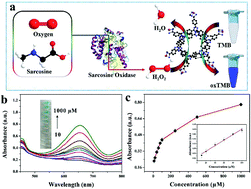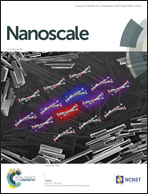Water dispersed two-dimensional ultrathin Fe(iii)-modified covalent triazine framework nanosheets: peroxidase like activity and colorimetric biosensing applications†
Abstract
Peroxidase mimics have attracted increasing attention as emerging artificial enzymes due to their promising applications in many fields, including bionanotechnology, sustainable chemistry, and environmental remediation. Although many types of peroxidase mimics have been successfully exploited in the past decade, the development of an innovative peroxidase mimic that does not contain noble metals, but exhibits remarkable peroxidase-like activity and low cytotoxicity still remains a major challenge in this field. Herein, we present a bulk covalent triazine framework cleavage and metal atom anchoring strategy for the synthesis of iron-modified two-dimensional covalent triazine frameworks (2D Fe-CTFs) that demonstrate excellent peroxidase-like activity. Furthermore, three kinds of colorimetric sensing platforms for sarcosine, ochratoxin A, and fluoride ions were constructed based on the intrinsic peroxidase-like activity, salt-induced coagulation, and coordination competition of the 2D Fe-CTF, respectively. This work may provide a new synthetic method for peroxidase mimics that can be used in various colorimetric sensors.



 Please wait while we load your content...
Please wait while we load your content...